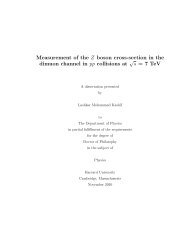2 The CDF Experiment at Fermilab Contents - Harvard University ...
2 The CDF Experiment at Fermilab Contents - Harvard University ...
2 The CDF Experiment at Fermilab Contents - Harvard University ...
You also want an ePaper? Increase the reach of your titles
YUMPU automatically turns print PDFs into web optimized ePapers that Google loves.
88 Section 2: <strong>CDF</strong> Physics Analysis<br />
2.4.7 B Mixing and CP Viol<strong>at</strong>ion<br />
(Prof. Huth, Dr. Maksimovic & Mr. Bailey)<br />
In the next few years several experiments will come online with the intention of detecting<br />
and measuring CP viol<strong>at</strong>ion with B mesons in several decay modes. <strong>The</strong>se include dedic<strong>at</strong>ed<br />
B factory experiments such as Belle and BaBar as well as hadronic experiments such as <strong>CDF</strong>.<br />
<strong>CDF</strong> has already demonstr<strong>at</strong>ed its potential to measure B sector CP viol<strong>at</strong>ion with the recent<br />
measurement of the CP viol<strong>at</strong>ing parameter sin(2) =0:790:390:16 [24] using the decay<br />
mode B 0 ! J= K s in the Run I d<strong>at</strong>a. This analysis used a B 0 avor tagging algorithm<br />
developed by Maksimovic for his thesis. <strong>CDF</strong> II should be able to signicantly improve this<br />
measurement as well as measure other CP viol<strong>at</strong>ing parameters with other decay modes.<br />
<strong>The</strong> <strong>Harvard</strong> group will be involved with these studies, especially those involving B s mesons.<br />
<strong>The</strong> group has interest in CP viol<strong>at</strong>ion studies using B s ! Ds K and B s ! J= as well<br />
as the requisite measurements of B s mixing and avor tagging. Contributions have already<br />
been made in the area of a signal to background study, avor tagging algorithms, and a<br />
feasibility study for B s ! Ds K .<br />
<strong>The</strong>se B physics interests are directly rel<strong>at</strong>ed to our work on the Silicon Readout Controller<br />
(SRC) for the Silicon Vertex Detector d<strong>at</strong>a acquisition system (SVX DAQ). <strong>The</strong> SVX<br />
DAQ is designed to process a 40 kHz level 1 accept r<strong>at</strong>e and trigger on B events <strong>at</strong> level<br />
2. This ability is unique to <strong>CDF</strong> and is crucial to acquiring a large and pure B sample for<br />
performing these B physics studies.<br />
<strong>The</strong> Unitarity Triangle<br />
In the Standard Model, CP viol<strong>at</strong>ion arises from a single complex phase in the V CKM<br />
mixing m<strong>at</strong>rix which rel<strong>at</strong>es the quark mass and weak eigenst<strong>at</strong>es. By tre<strong>at</strong>ing the elements<br />
of the unitarity rel<strong>at</strong>ion<br />
V ud V <br />
ub + V cd V <br />
cb + V td V <br />
tb =0<br />
as vectors in the complex plane, one may form the \unitarity triangle" which ne<strong>at</strong>ly summarizes<br />
the relevant parameters in B meson CP viol<strong>at</strong>ion studies. Dierent decay modes of<br />
B mesons produce CP viol<strong>at</strong>ing eects proportional to the sine of various combin<strong>at</strong>ions of<br />
these angles.















